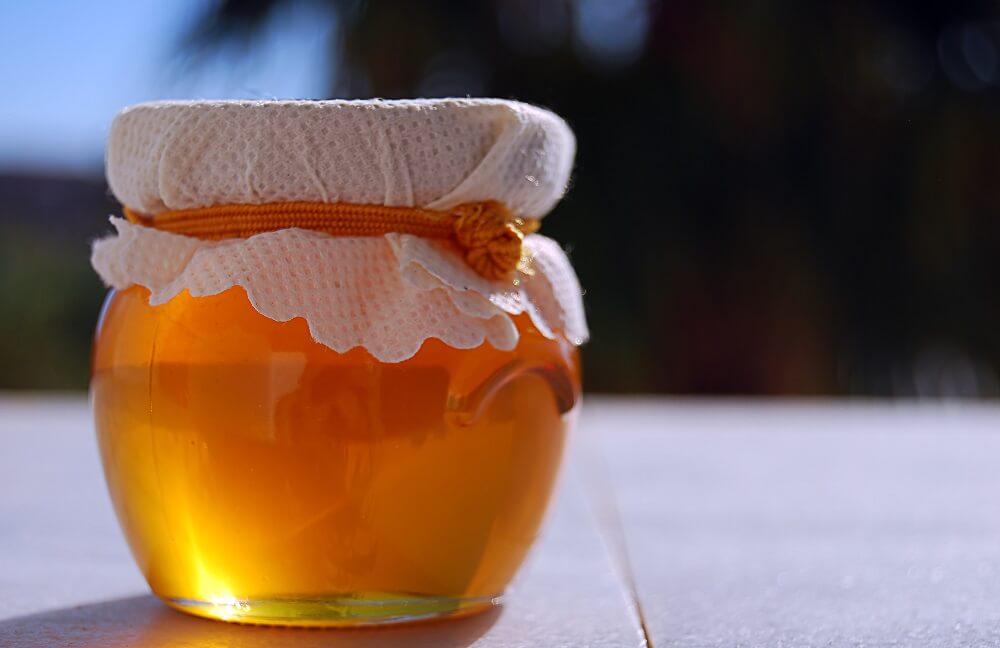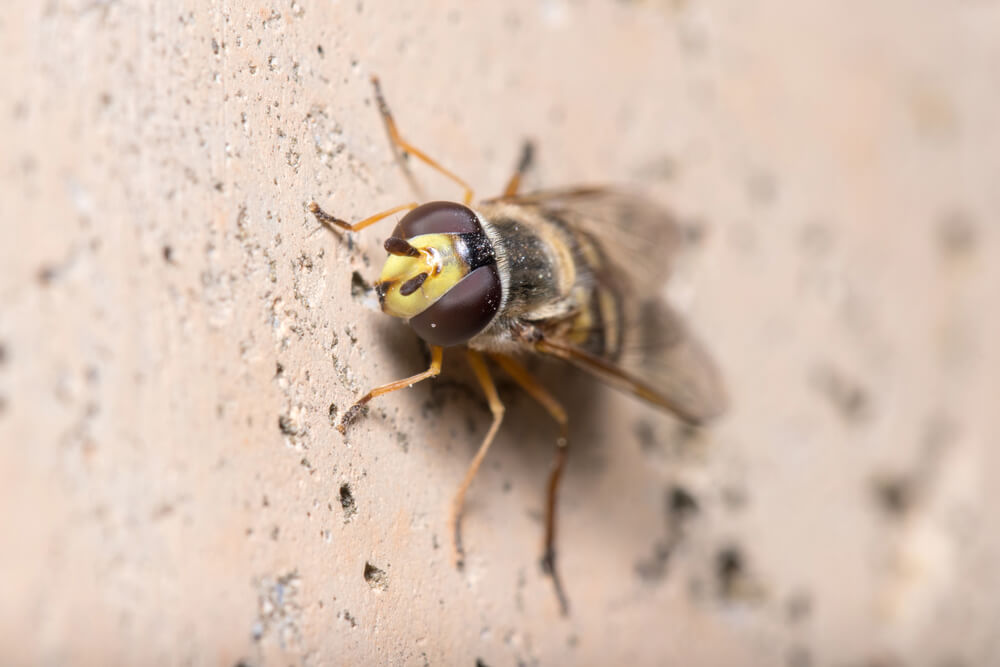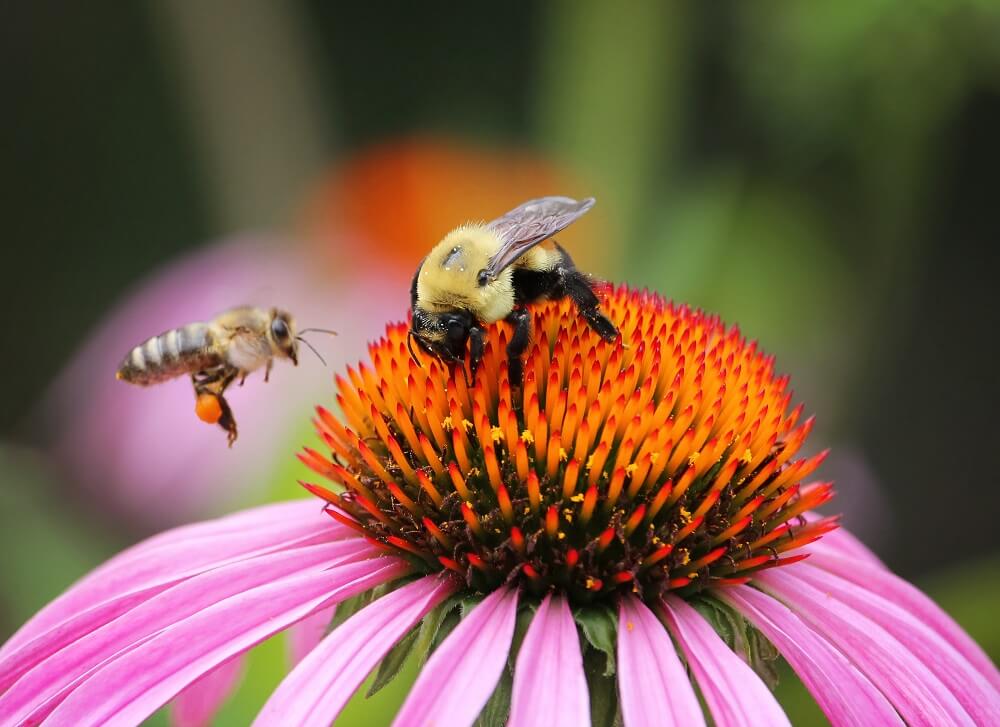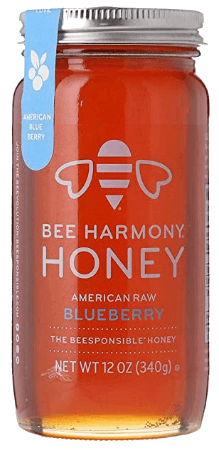Table of Contents:
Is Honey Bee Vomit?
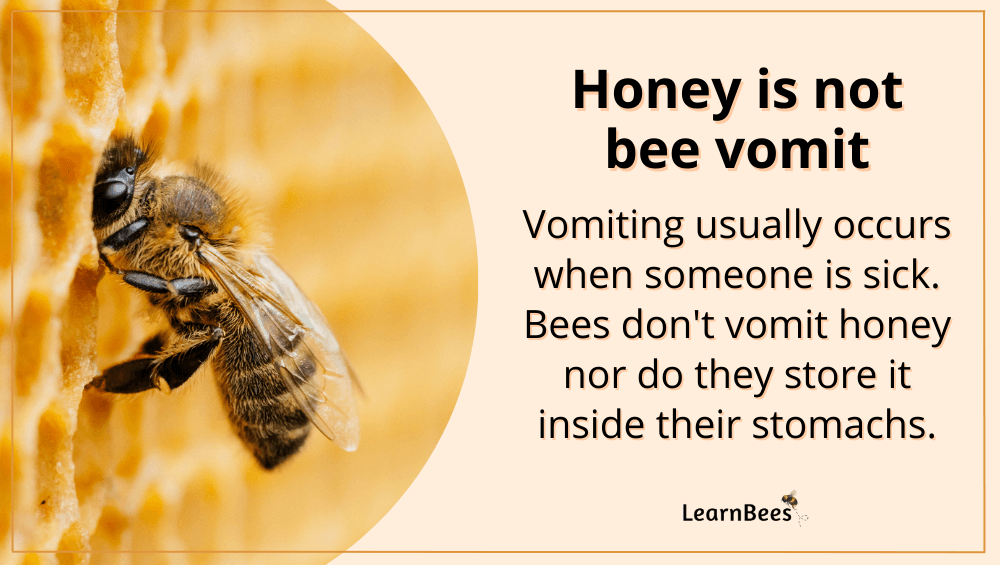
Simply put, honey is not bee vomit.
Let me explain.
The definition of vomit is to eject matter from the stomach through the mouth. The synonyms for this definition are to “be sick” and “get sick.”(1)
Here’s the critical part:
Bees don’t store honey inside their stomachs nor do they vomit it up. Instead, bees store honey in a special ‘honey crop’ inside their bodies.
How do they do it?
It starts with the honeybee collecting nectar from flowers. As the honeybee drinks the nectar, it goes into the bee’s ‘honey crop,’ where it’s mixed with special enzymes. From there, this hardworking little honeybee collects nectar from 50-100 flowers until its honey crop is full.
The honeybee then flies back to its hive with a full crop. Once home, it regurgitates the nectar. The nectar then gets ingested by other bees, who use their own enzymes to break down the sugars further.
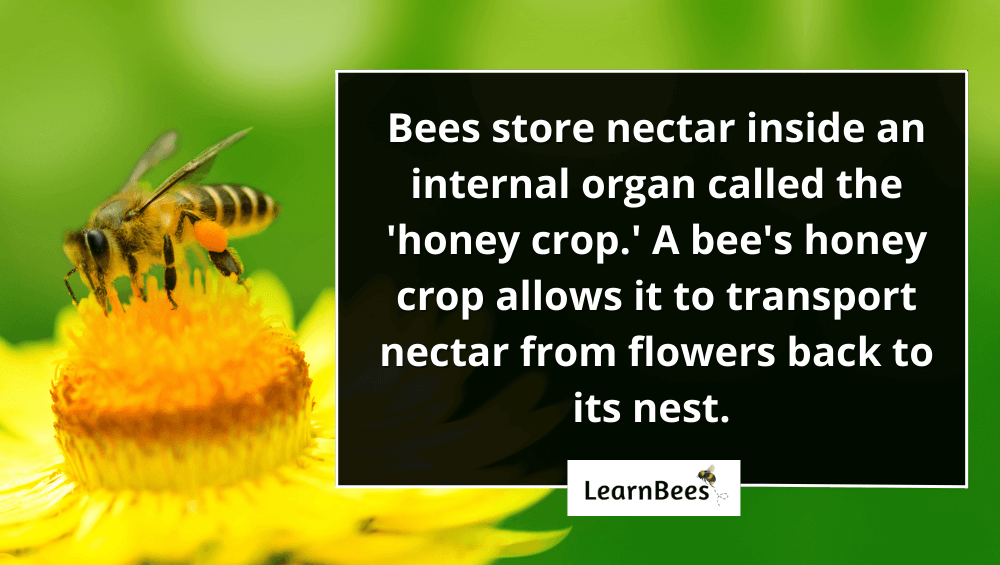
And once that process is complete?
The bees regurgitate the nectar into honeycomb cells, where they fan their wings furiously to evaporate extra water out of it. As the water evaporates, the nectar thickens into honey.
But remember:
Vomit is defined as the ejection of stomach contents, usually associated with sickness.
On top of that, regular vomiting poses serious health risks for humans, such as low blood potassium levels or esophagus damage. Regular vomiting can even cause severe corrosion to teeth due to stomach acids.(2, 3, 4)
So keep in mind:
Honeybees regurgitating honey doesn’t come from their stomach and doesn’t happen because they’re sick. Regurgitating honey is safe, natural, and necessary for their survival.
If anything, you could argue that honey is bee spit because the action of regurgitation is similar to spitting. But vomiting? Now that’s a stretch.
More importantly?
A bee’s honey crop isn’t the same thing as its stomach. They’re two different organs. Their stomach is for digesting food, and their honey crop is for storing honey.
Take a look:

But this is where the confusion comes in because people refer to a bee’s honey crop as a ‘honey stomach.’
The only problem?
The honey crop isn’t a stomach.
A stomach is defined as an organ that digests food. A bee’s honey crop doesn’t digest the honey. It simply stores it. Bees have a stomach for digestion, but it’s a separate organ from their honey crop entirely.
Eric Mussen, an apiculturist, says, “Although many sources refer to the honeybee crop as the ‘honey stomach,’ it is not a place where consumed foods are being digested in honey bees.”
Mussen adds, “Honey is not actually bee vomit as it never goes through a digestion (breakdown) process in the digestive tract of a honeybee.”
This is an important distinction.
So let me ask you:
Does honey look like vomit? Does it taste like vomit, smell like vomit, or feel like vomit?
Absolutely not.
Now, the question becomes…
What is Honey, Exactly?

Honey is a sticky, sweet substance made by bees and other insects. More specifically, honeybees make honey from the sugary secretions of plants (nectar).
And you know what?
Honey is not only delicious, but it’s also antibacterial, anti-inflammatory, and chock-full of health benefits. A few benefits include:
- Honey is an effective wound treatment that helps kill harmful bacteria, thus helping to prevent infections.(5, 6)
- Honey is a helpful treatment for skin conditions, such as psoriasis, dermatitis, and herpes.(7, 8, 9)
- Honey has been demonstrated to be more effective than cough syrup in treating sick children.(10)
Why do I point these things out?
Because the implication that honey is “bee vomit” often comes from people trying to convince you that honey is somehow gross or unsanitary. It also comes from media outlets that want to grab your attention with click-bait headlines such as FYI, Honey is Actually Bee Vomit.
Do headlines like that grab attention? Certainly.
Are they true? Not quite.
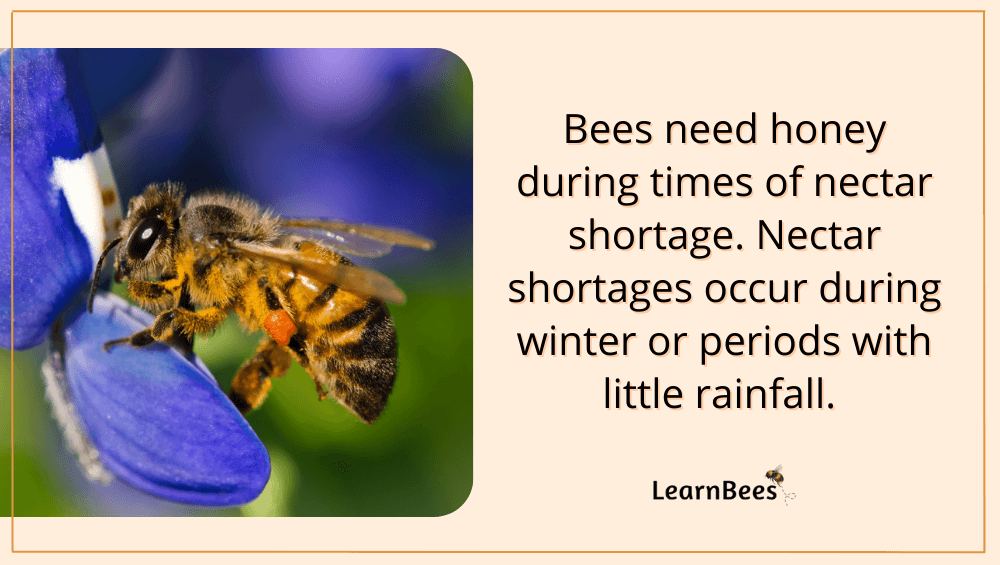
Now let me state the obvious:
Bees and humans are different. So comparing a bee system with a human system is like comparing apples and oranges. We both have unique ways of seeing, tasting, feeling, and smelling things.
For example, it might surprise you to learn that bees can taste things through their feet. Or that bees have five eyes that see the world in a completely different way than we do.
What am I saying?
As humans, we naturally look at things through a human lens. This is normal. However, a problem arises when people start implying something is “gross” or “unsanitary” when, in fact, it isn’t.
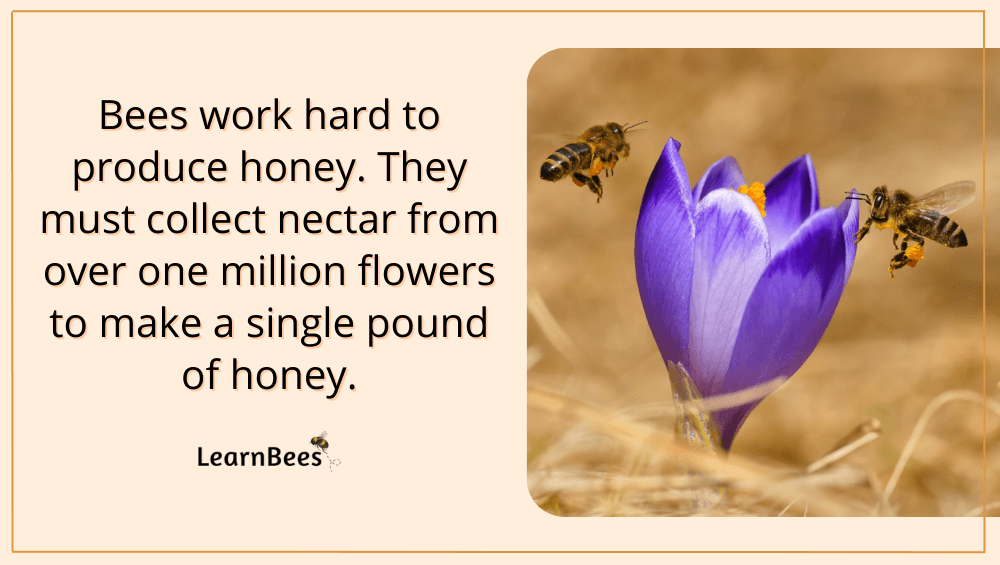
We should be careful to ensure we’re not doing a disservice to the incredible creatures that work hard to produce honey.
If you’re still skeptical, ask yourself these questions:
If you chew something up and spit it out, is that vomit?
No, because it wasn’t fully digested and didn’t come out of your stomach.
If you choke on your food and someone gives you the Heimlich maneuver so you can spit it out, is that vomit?
No, because even though you chewed it up and swallowed it, it wasn’t in your stomach.
Honeybees don’t digest the honey, nor are they sick as they regurgitate it. They simply store it inside their honey crop while foraging for food.
Final Thoughts on Honey Bee Vomit

This all comes back to the humans.
Those pesky humans.
Sometimes the truth gets in the way of a juicy storyline. That’s why headlines such as Honey is Bee Vomit get more attention than Honey is Not Bee Vomit. Media companies know what sells and what doesn’t.
It doesn’t stop there, though.
I’ve also seen headlines proclaiming that beeswax is bee poop. But beeswax is no more like poop than the earwax from human ears. Beeswax is a glandular excretion, not the waste product of the digestive system.
But I get it.
Things become confusing when people refer to a bee’s honey crop as a ‘honey stomach.’
At the end of the day?
It’s nothing to get bent out of shape about. Bees are wonderful creatures that produce over 300 flavors of honey. I think that’s incredible, and I know you do too.
So thank you, bees, for all your hard work.
FAQs on “Is Honey Bee Vomit?”
- What’s the difference between nectar and honey?
- How often do bees regurgitate nectar?
- Do all bees regurgitate nectar?
- Why do some people refer to honey as bee vomit?
What’s the difference between nectar and honey?
Nectar is a sugary liquid that plants secrete. It’s the primary carbohydrate source for bees, giving them the energy and calories needed to function. Nectar also serves as a sweet substance that attracts other pollinators such as butterflies, hummingbirds, and beetles.
But nectar is more than just a sweet substance.
It’s also rich in vitamins, oils, salts, and other nutrients. It’s produced by plants in a gland called the nectaries. Depending on the type of plant, the nectaries may be located on different parts of the flower, including the stamen, pistils, and petals.
So why do plants produce nectar?
Pollen must travel from one flower to another for many plants to reproduce. But since plants don’t move, they require pollination help from pollinators. So to entice pollinators to their flowers, plants provide nectar.
While feeding, pollen sticks to the bees. As the bees move from blossom to blossom, pollen is transferred with every visit.
The pollinator is just out for a meal but is unknowingly helping the plant reproduce.
Honey comes from nectar and is made by only a limited number of bee species. Examples include honeybees, bumblebees, Australian sugarbag bees, and vulture bees.
Honey’s color, taste, texture, and aroma vary greatly depending on the type of flower it comes from. Blueberry honey, for example, differs significantly from orange blossom honey.
—> Go back to the FAQs on “Is Honey Bee Vomit?”
More to Explore:
How often do bees regurgitate nectar?
It depends.
For example, worker honeybees are the bees responsible for making honey. During the warm months, worker honeybees make honey daily. During the cold months, honeybees huddle together and eat their honey storage to survive.
But here’s the thing:
Most bees actually don’t make honey. Bees that make honey are social bees that live in colonies. Such colonies consist of a queen bee, worker bees, and drone bees.
But here’s the thing:
There are over 20,000 bee species globally. Over 90% of said bee species are solitary bees that don’t make honey.
In contrast, examples of bees that do make honey are honeybees, bumblebees, and Australian sugarbag bees.
Honeybees are the only bees that make enough honey for human consumption. A strong honeybee hive can make dozens of pounds of honey per year. That said, not every honeybee in the colony is tasked with making honey.
For instance, queen honeybees don’t make honey. Their primary job is to lay eggs to ensure the future generation of honeybees. Also, drone honeybees don’t make honey. Drones are male bees solely responsible for mating with queens from other hives.
—> Go back to the FAQs on “Is Honey Bee Vomit?”
More to Explore:
Do all bees regurgitate nectar?
No.
Male bees don’t regurgitate nectar because they don’t make honey, nor do they feed larvae. Male bees are called drones, and their sole job is to mate with virgin queens.
For the honeybee species, the worker honeybees are responsible for collecting and regurgitating nectar. They store it inside their honey crop, where it gets mixed with special enzymes. From there, honeybees regurgitate the nectar and use a wing fanning technique to evaporate the excess water so it can thicken into honey.
All bee species regurgitate nectar at some point. But it isn’t necessarily to make honey.
For instance, mason bees don’t make honey because they’re solitary bees that live alone. But, they do regurgitate nectar from flowers to feed their larvae.
This is because larvae need to eat, but they aren’t fully-developed bees yet. And since larvae can’t go out and collect nectar and pollen themselves, they rely on the female adult bee to feed them.
So, in a nutshell:
A bee’s primary diet consists of pollen and nectar from plants. Female bees will collect nectar from flowers, bring it back to their nest, then regurgitate it to feed their young.
—> Go back to the FAQs on “Is Honey Bee Vomit?”
More to Explore:
- Ground Bees: Are They a Threat to Your Yard?
- Wasps vs. Honeybees: Are They Different?
- Do Bumble Bees Bite?
Why do some people refer to honey as bee vomit?
There are many reasons why people refer to honey as bee vomit. It’s a common myth. As such, it often provokes countless questions such as:
Is honey bee throw up? Is honey made from bee vomit? Is honey bee vomit or spit? What is bee vomit? How come honey is not bee vomit? Is honey dried bee vomit? Is honey made from nectar and bee vomit? Is honey really bee vomit? Is honey bee vomit or poop?
The main reason people refer to honey as bee vomit is probably because of the misconception about a bee’s honey crop.
A bee’s honey crop is an internal organ used to store nectar and honey. Many people often call it a ‘honey stomach,’ which leads to confusion.
Let me reiterate:
A bee’s honey crop and stomach are two separate organs. Their stomach is used to digest food, while their honey crop stores honey. So when a bee regurgitates honey from its honey crop, it isn’t vomiting it up.
The definition of vomit is to throw up matter from the stomach through the mouth. Synonyms for this definition are “be sick” and “get sick.”
The bee is not sick while regurgitating honey, nor does it come from its stomach.
